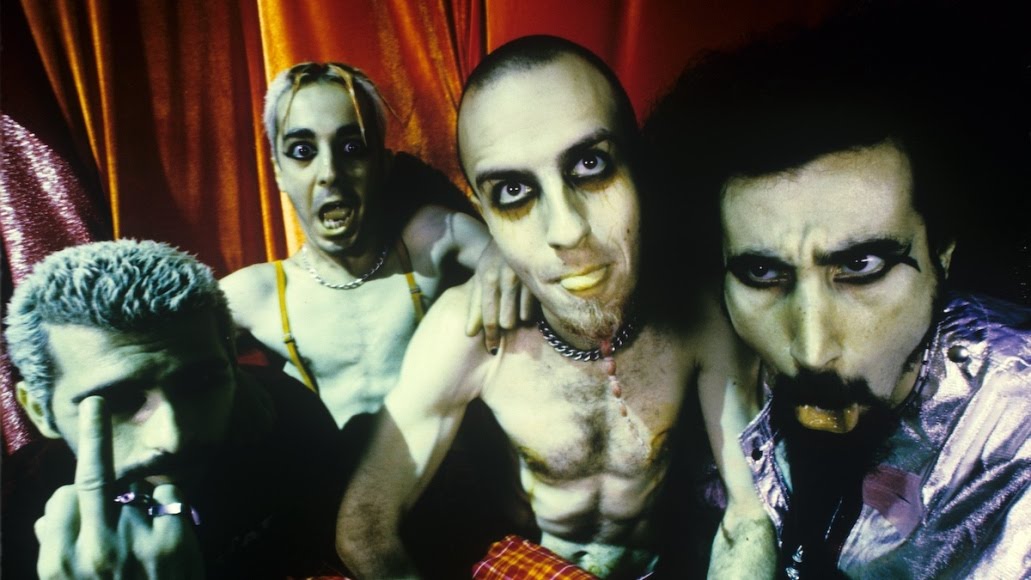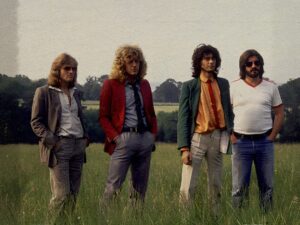The eclectic and explosive 1998 LP introduced the world to one of rock’s most unique acts
“We are not an Armenian band, we are not a heavy metal band, and we aren’t nu-metal,” guitarist-singer Daron Malakian clarified to alma mater Glendale High School in 2003. “We are System of a Down. … We are what rock music has evolved into.”
Of course, those attributes are an integral part of their history and creativity (they were even told early on that they were unmarketable because of their ancestry). Yet, every album they’ve done has demonstrated a remarkable refusal to be pigeonholed by specific genres and topics.
Naturally, their self-titled debut LP — co-produced by industry legend Rick Rubin and released on June 30th, 1998 —firmly established their unique artistry. With its wide range of styles (thrash metal, hardcore, funk, Middle Eastern, jazz, noise rock, hip-hop, punk) and subject matter (genocide, religious extremism, self-harm, predacious media, mind control, drug abuse), it showcased a startlingly inventive and motivated ensemble who bowed down to no one.
The road to the album’s release took a few winding turns along the way. For starters, the group arose from the ashes of Soil, an early ‘90s California quintet that included future SOAD bandmates Malakian, Serj Tankian, and Shavo Odadijan (who started out as their manager). Following Soil’s disbandment, the three aforementioned members decided to start a new band under a new name: Victims of a Down (titled after one of Malakian’s poems).
Before long, though, they swapped “Victims” to “System” because – as Tankian once explained – it was “a better, stronger word.” Additionally, according to Malakian, it allowed them to be alphabetized in record shops alongside one of their biggest influences: Slayer. (In fact, Malakian described their music as “Slayer and the Beatles [having] a baby.”)
Throw in a few more diverse inspirations – such as Ravi Shankar, David Bowie, Alien Sex Fiend, The Who, Bad Brains, and Black Sabbath – and you have their first four demo tapes (which they shopped around to labels during the mid-90s). Logically, they were also playing local shows in California, and by 1997, they’d caught Rubin’s attention and cemented their lineup by replacing drummer Ontronik “Andy” Khachaturian with John Dolmayan
Interestingly, Rubin was initially hesitant to get involved, as he reflected in a 2009 chat with Q magazine: “I loved them. They were my favorite band, but I didn’t think anyone was going to like them apart from a small, likeminded group of people like me who were crazy. No one was waiting for an Armenian heavy metal band. It had to be so good that it transcended all of that.”
To his point, several labels passed on them, but they were also sought after by Roadrunner, Universal and Rubin’s own American/Columbia Records. In the book Louder Than Hell, Malakian recalled almost signing with Universal before realizing that “they didn’t have any rock acts [on their office walls] or . . . anybody in there that knew what to do with rock.” Thus, they chose to go with Rubin.
“He believes in us and he’s not following any trends. He’s just going with his instinct,” Malakian added.
Together, they split recording/production duties between Sound City Studios and Rubin’s home studio (The Mansion). In 2019, Tankian told Alexis magazine that working with Rubin was “surprisingly easy” and “a lot of fun.” Plus, SOAD were able to expand their characteristically malleable and frenetic sound, embodying daily mood shifts in an attempt to “bring all of that kind of life emotion into the music” (as Tankian explained to Pulse! magazine when the album came out).
Upon its release, singles “Sugar” and “Spiders” – both of which made Heavy Consequence‘s list of the band’s Top 10 Songs – earned heavy rotation at rock radio stations and on MTV. The quartet even performed “Spiders” on Late Night with Conan O’Brien, as well as had songs from the album featured in Scream 3, Daria, and the 2002 war drama Ararat (which revolved around the Armenian genocide of the late 1910s).
Twenty-five years on, the self-titled LP endures as a brilliantly illustrative glimpse into its creators’ remarkable chemistry.
Opener “Suite-Pee” – as well as “Sugar,” “Mind,” “Know,” “CUBErt,” “Soil,” and closer “P.L.U.C.K.” – have their own engrossing idiosyncrasies amidst encapsulating SOAD’s knack for abrasively poetic social commentary, quirkily rough guitarwork, flamboyant singing/narration, and absorbing rhythmic changes. Their black/death metal tendencies, including growls, also highlight why the album might be the foursome’s most consistently fierce sequence.
Elsewhere, the collection foreshadows the sundry strangeness of future gems.
For example, the combination of melodic moodiness and bizarre vocalizations make “Suggestions” feel like a direct ancestor of songs like “Aerials” and “Cigaro.” Afterward, the mellow anguish of “Spiders” alludes to mournful tone of “Lost in Hollywood,” whereas the vibrant hyperactivity of “DDevil” and the hectic political critiques of “War?” are clear precursors to “B.Y.O.B.” and “Prison Song,” respectively. Even the eerie, polka-esque templates of “Peephole” and “Darts” evoke the danceable belligerences of “Chic ‘n’ Stu” and “Kill Rock ‘n Roll.”
“System of a Down is four distinctive parts that work well together. . . . Don’t ask me why, but it works. Hey, I’m just as amazed as you probably are that we are a household name,” Malakian said in the same Glendale High School interview.
Considering its fairly esoteric nature, it’s somewhat surprising that System of a Down became so popular. “We’ve had an incredible response from the media and from fans. . . . We played the main stage at Ozzfest and a lot of people knew us already. To be able to do that in a year, with a new band? I think that’s incredible,” Tankian told Metal Edge in 1999. He had a point, as the LP also led to them touring with the likes of Slayer, Metallica, Fear Factory, Korn, Incubus, and Mr. Bungle.
While the band would reach new heights with its massive follow-up, Toxicity, it was System of a Down that inarguably laid the groundwork for their artistic and commercial triumphs. Sure, it’s not as polished as its successors, but it nonetheless demonstrates how much of System of a Down’s singular DNA was intact from the beginning.



